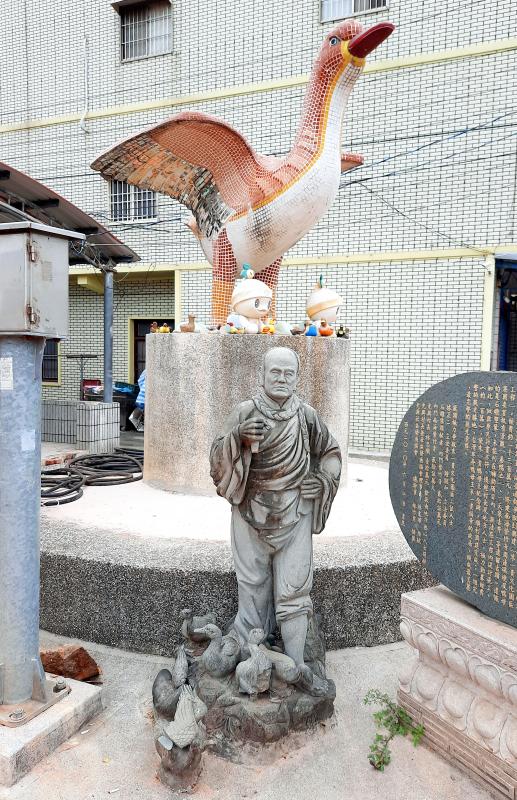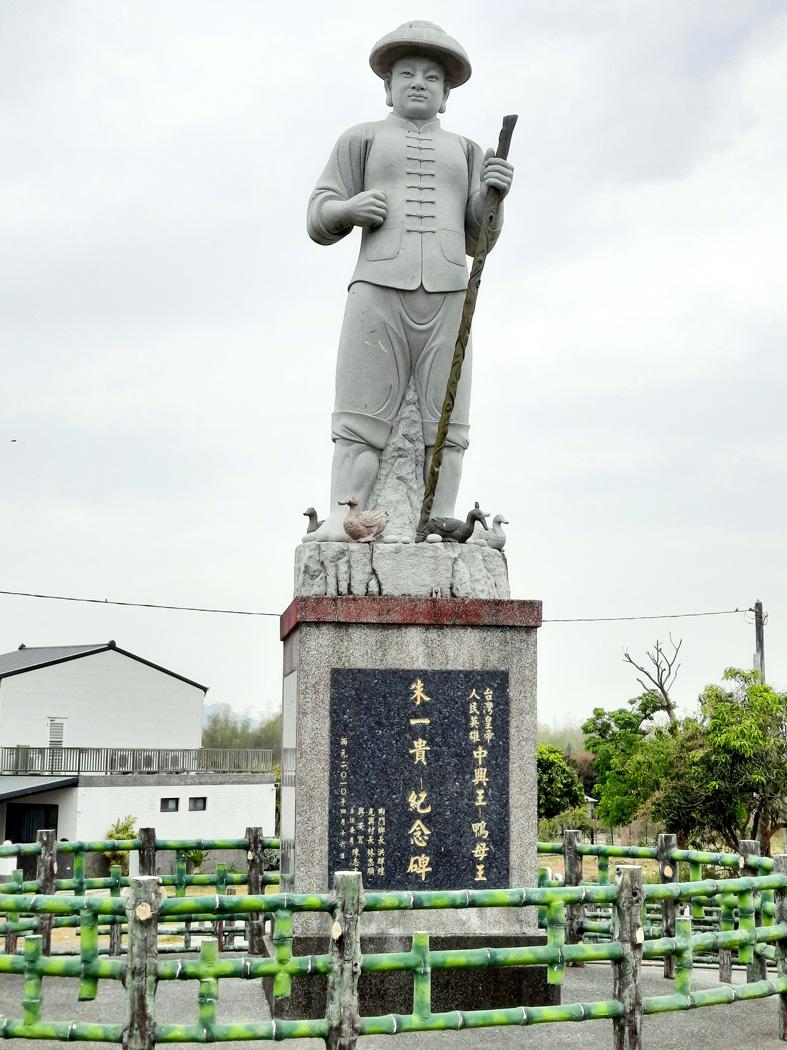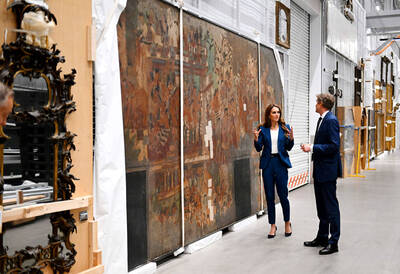Chu Yi-kuei (朱一貴) was a nobody for all but the final few months of his life. Before his grisly end, however, he achieved something that eluded all of the many other Taiwanese who rebelled against Qing Dynasty authorities between 1684 and 1895. He and his followers captured Tainan, then Taiwan’s center of government and commerce.
Perhaps because COVID-19 has been dominating the news, the 300th anniversary of his uprising passed with hardly a comment.
In early 1721, Chu — like many Han settlers in the southwest — was outraged by the extortionate practices of Taiwan Prefect Wang Jhen (王珍) and Wang’s son, who also held an official post.

Photo: Steven Crook
It seems that Chu’s co-conspirators wanted him to lead the rebellion, because he bore the same family name as the Ming Dynasty emperors whom the Qing had overthrown. It’s hard to know how much residual loyalty to the Ming still existed in Taiwan at that time, 38 years after the collapse of the Ming-loyalist state that snatched Tainan from the Dutch, but it was enough to worry the Qing.
RAPID COLLAPSE
The collapse of Qing authority was shockingly rapid.

Photo: Steven Crook
Chu’s ragtag force, which initially numbered no more than 80, began their campaign on the 19th day of the fourth lunar month by raiding a weapons depot in what’s now Gangshan District (岡山) in Kaohsiung.
Local officials responded quickly. However, according to John Robert Shepherd’s Statecraft and Political Economy on the Taiwan Frontier 1600-1800, “several government missteps in the following days caused the revolt to spread and escalate.”
One of the worst blunders was to offer a bounty to Qing loyalists for every rebel killed. After innocent civilians were murdered and houses set afire, terrified villagers threw their support behind Chu.

Photo: Steven Crook
By the end of the month, the military situation had deteriorated to the point that Qing officials in Tainan were putting their families on ships, ready to flee to the Penghu Islands.
Tainan fell on the first day of the fifth month. Within days, Chu and his allies had also seized Jhuluo (諸羅, now known as Chiayi). He was declared king, but infighting soon weakened his regime.
In the middle of the sixth month, thousands of Qing soldiers landed near Tainan. Better equipped than the rebels and supported by Hakka militia, they were able to crush the uprising within a few weeks.

Photo: Steven Crook
Chu was captured alive and taken to Beijing. There, he and other ringleaders were subjected to lingchi (凌遲), a barbarously drawn-out form of execution sometimes called “death by a thousand cuts.”
The duck farmer had gone from obscurity to oblivion, but he wasn’t forgotten. In Kaohsiung’s Neimen District (內門), some said he’d shown remarkable leadership long before the uprising. He trained his ducks to form up and march like soldiers, they claimed.
CULTURE PARK
The Chinese Nationalist Party (KMT) regime that controlled Taiwan between 1945 and 2000 lionized Taiwanese who’d fought the Qing or the Japanese. To celebrate the exploits of Chu Yi-kuei, in 1998 the government unveiled the Yamuliao Chu Yi-kuei Culture Park (鴨母寮朱一貴文化園區) in a rural part of Neimen.
The centerpiece of the park is Singan Temple (興安宮), in which Chu is enshrined. He’s on the right as you face the front. The central position is occupied by the sea goddess Matsu; here she’s known as the Heavenly Holy Mother (天上聖母).
There are two statues of Chu in the immediate vicinity. You might miss the one nearest the temple, as it’s overshadowed by a gigantic duck. The duck stands atop a sealed well from which Chu is said to gotten his water.
The other statue is on a pedestal above a green pond. The water feature was dug when the park was established, to better recreate the atmosphere of a duck farm.
A stele just outside Siaonan Chenghuang Temple (小南城隍廟) in downtown Tainan provides a short biography of Chu, who’s now worshipped inside the shrine as the Second City God (小南二城隍爺).
It doesn’t mention if Chu had a wife or children. In the traditional society in which he lived, it would have been highly unusual for a man in his early 30s to be unmarried. Yet the Taiwan of yore suffered from a serious gender imbalance. Most migrants were unaccompanied males; according to Shepherd, the migration of families to Taiwan was prohibited for 92 of the first 104 years of Qing rule.
Honoring Chu as a deity who can protect Tainan is poacher-turned-gamekeeper logic. Who’d know better how to keep invaders out than the only man to breach the city’s defenses?
There’s nothing remotely farmer-like about the effigy of the Second City God. He’s positioned at the rear of the temple, in the very center, right in front of Matsu.
DUCK KING TEMPLE
Another shrine devoted to Chu exists in Kaohsiung’s Linyuan District (林園). I’ve not been able to visit or even confirm a formal address for what’s known simply as the Duck King Temple (鴨母王廟). It’s on the north side of Jhongsiao East Road (忠孝東路), less than 50m west of Provincial Highway 25.
It’s said that, during the 1895-1945 period of Japanese colonial rule, a local man seeking a cure for his mother’s illness passed this spot late at night. To his surprise, he saw a large group of ducks. They quacked loudly, then disappeared.
In the days and weeks that followed, people in the area reported dreaming about Chu. This, combined with the sudden and inexplicable recovery of the man’s mother, prompting residents to establish an altar so they could offer incense to the long-deceased duck farmer.
His kingdom may have swiftly crumbled, but two centuries after his death, the Duck King was still inspiring awe among Taiwanese.
Steven Crook has been writing about travel, culture and business in Taiwan since 1996. He is the author of Taiwan: The Bradt Travel Guide and co-author of A Culinary History of Taipei: Beyond Pork and Ponlai.

June 9 to June 15 A photo of two men riding trendy high-wheel Penny-Farthing bicycles past a Qing Dynasty gate aptly captures the essence of Taipei in 1897 — a newly colonized city on the cusp of great change. The Japanese began making significant modifications to the cityscape in 1899, tearing down Qing-era structures, widening boulevards and installing Western-style infrastructure and buildings. The photographer, Minosuke Imamura, only spent a year in Taiwan as a cartographer for the governor-general’s office, but he left behind a treasure trove of 130 images showing life at the onset of Japanese rule, spanning July 1897 to

One of the most important gripes that Taiwanese have about the Democratic Progressive Party (DPP) is that it has failed to deliver concretely on higher wages, housing prices and other bread-and-butter issues. The parallel complaint is that the DPP cares only about glamor issues, such as removing markers of Chinese Nationalist Party (KMT) colonialism by renaming them, or what the KMT codes as “de-Sinification.” Once again, as a critical election looms, the DPP is presenting evidence for that charge. The KMT was quick to jump on the recent proposal of the Ministry of the Interior (MOI) to rename roads that symbolize

On the evening of June 1, Control Yuan Secretary-General Lee Chun-yi (李俊俋) apologized and resigned in disgrace. His crime was instructing his driver to use a Control Yuan vehicle to transport his dog to a pet grooming salon. The Control Yuan is the government branch that investigates, audits and impeaches government officials for, among other things, misuse of government funds, so his misuse of a government vehicle was highly inappropriate. If this story were told to anyone living in the golden era of swaggering gangsters, flashy nouveau riche businessmen, and corrupt “black gold” politics of the 1980s and 1990s, they would have laughed.

Imagine being able to visit a museum and examine up close thousand-year-old pottery, revel alone in jewelry from centuries past, or peer inside a Versace bag. Now London’s V&A has launched a revolutionary new exhibition space, where visitors can choose from some 250,000 objects, order something they want to spend time looking at and have it delivered to a room for a private viewing. Most museums have thousands of precious and historic items hidden away in their stores, which the public never gets to see or enjoy. But the V&A Storehouse, which opened on May 31 in a converted warehouse, has come up